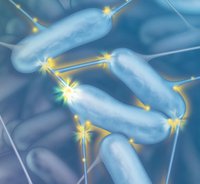
Reduction-oxidation (redox) reactions and electron transport are essential to life’s energy conversion pathways. But what if there was also a direct link allowing electron exchange between the living and non-living worlds? We now know that some anaerobic bacteria gain energy through extracellular electron transport to natural minerals or synthetic electrodes that serve as electron acceptors for respiration outside the cells. In addition to the fundamental implications for physiology and astrobiology, where interfacial electron transport may form the basis of an extraterrestrial metabolism on iron-rich planets, a physics-based understanding may enable the transmission and control of signals at hybrid living/synthetic interfaces.
But how can a bacterium transport electrons to an external surface? In this talk we will describe how bacteria organize redox sites on outer cell membranes, and along quasi-one-dimensional filaments known as bacterial nanowires, to facilitate long-range charge transport. The approaches taken include microfluidic fluorescence assays, gene expression profiling, single-cell electrochemical measurements, scanning tunneling microscopy of redox molecules, and nanofabrication-enabled measurements of transport along individual nanowires produced by the iron reducing bacterium Shewanella oneidensis MR-1. Based on these measurements, we propose that extracellular respiration is facilitated by an incoherent multistep charge hopping mechanism along redox chains. Finally, we will describe in vivo measurements demonstrating that the S. oneidensis MR-1 nanowires are lipid-based extensions of the outer membrane and periplasm that include the multiheme cytochromes responsible for extracellular electron transport. Redox-functionalized membrane and vesicular extensions may represent a general microbial strategy for electron transport and energy distribution.
 A Talk With Jim Green
A Talk With Jim Green What Can Extant Genomes Reveal About Early DNA Metabolism?
What Can Extant Genomes Reveal About Early DNA Metabolism? What We Talk About When We Talk About Earth's Oxygenation
What We Talk About When We Talk About Earth's Oxygenation Bowling With Astrobiologists: A Twisted Path Toward the Origin of DNA
Bowling With Astrobiologists: A Twisted Path Toward the Origin of DNA